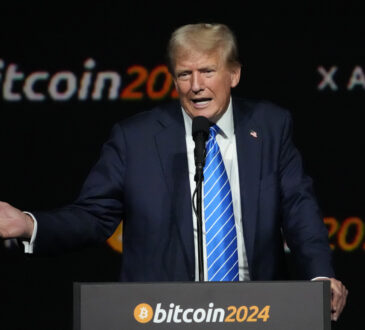
Stablecoins have been seen as the trustedpart of the crypto world for traders and regulators.
The new Markets in Crypto Assets (MiCA) brought in by the EU’s European Securities and Markets Authority that came into force in June, sees stablecoins as the bridge between the traditional and crypto financial worlds.
While many central banks are exploring the feasibility of Central Bank Digital Currencies using stablecoins or the blockchain platforms they are on, as a route to their digital currency.
However, not too long ago their future was in question with the collapse of the Silicon Valley Bank in 2023, forcing Circle’s USD Coin to lose its dollar peg,
trading at 87 cents rather than $1. In 2022, the crypto prices collapsed when stablecoin
Terra fell below have its pegged value.
So how stable are stablecoins? As the Bank for International Settlements looks to improve foreign currency (FX) trading by using blockchain with Project Marina, it is important we understand the mechanisms and affect of FX trading in the crypto world.
Together with Angelo Ranaldo, of the University of Basel, and Junxuan Wang, of the University of Cambridge, I conducted the first systematic study of blockchain currencies, specifically focusing on the euro/US dollar market and the stablecoins they are pegged
to, and comparing it to the traditional FX trading of the pair.
We found that while stablecoins pose some risks for regulators they do track the traditional financial markets and blockchain traders do use traditional market information, although they do not have equal access to that information.
Therefore, stablecoins can help address inefficiencies within traditional financial markets and offer possibilities for redesigning flaws within these markets.
Our research focuses on trade and price data on Circle’s euro stablecoin (EURC) and its US dollar version (USDC) from the Uniswap V3 exchange. The exchange, which uses Automated Market Maker (AMM) technology for pricing, provides a unique laboratory to test
the market efficiency of blockchain markets and their potential to replace traditional financial market infrastructure.
Trading in the EURC/USDC market should closely track developments in the traditional EUR/USD market, so we compared them to Reuters’ EUR/USD rates, which are widely considered indicative of the FX interdealer market.
We found that the blockchain market operates efficiently, with EURC/USDC prices within 20 basis points – i.e. 0.2 percentage points – of traditional EUR/USD market prices.
Blockchain prices are also responsive to macroeconomic information such as news from a press release on interest rates from the US Federal Reserve.
This finding is significant, given negative research and media narratives about stablecoins’ inherently risky nature. In fact, stablecoins do peg the mainstream currency market extremely well, and the deviations are less than researchers and policymakers
assume.
However, there are some frictions. One is ‘gas fees’- the fees necessary to authenticate transactions on blockchain markets. These can become expensive. The second is the volatility of the Ethereum blockchain market, which can cause losses for investors.
Both of these factors increase trading costs and reduce efficiency in the market, limiting the scope of blockchain-based markets’ ability to compete with traditional markets at scale.
Another key aspect of our research is investigating whether the blockchain market is acting in isolation, or if they are trading on a common information set.
We show that not all traders have equal access to information. As in traditional financial markets, information is asymmetric. Those with more information can impact price and leverage arbitrage opportunities – buying on one market and trading for a higher
price on another.
We identified three groups of traders: ‘sophisticated’ traders, ‘primary dealers,’ and ‘liquidity providers’.
Sophisticated traders, represented by the top 10 trading wallets, account for up to 50% of aggregate trading volume. They are informed due to their greater access to the traditional banking system and an enhanced capacity for arbitrage trades.
Primary dealers, with access to minting and redeeming stablecoins, share these informational advantages.
By contrast, liquidity providers have little price impact and are essentially uninformed hedgers disconnected from traditional market information.
These findings show that a significant number of traders have access to traditional market information and that the blockchain market does not act in isolation from conventional markets.
Indeed, we found that movements in the blockchain currency market can predict traditional FX rates. A one million change in order flow for EURC was associated with a 3.96% increase in the Reuters EUR/USD return.
Our findings have implications for the evolution of blockchain-based markets and their potential to transform traditional financial trading.
While blockchain trading offers a possibility for global financial inclusion and accessibility, our key message is that investors in the blockchain market are using fundamental information about developments in the traditional currency market. Blockchain
markets do not act in isolation. They can contribute to the price discovery process, where buyers and sellers establish the right price for a currency or commodity.
Importantly, we find asymmetric information among different groups of traders. This finding means the welfare of trading in these markets depends primarily on whether you are a large or small investor.
One concern is how these markets will evolve as they become much larger. The EURC/USDC market is still in its infancy and is a fraction of the trading in traditional foreign exchange markets.
Blockchain-based frictions, such as gas fees and other frictions, can make it difficult to achieve efficiency gains over conventional foreign exchange platforms.
Our research is a first step in understanding the potential of stablecoins in financial markets.
Our findings offer a balanced view, revealing that while stablecoins pose risks for regulators, they present opportunities to address volatility in blockchain markets.
Ultimately, they are a vital tool in the quest to redesign financial markets towards greater inclusion and increase efficiencies by reducing the need for intermediaries.
We have found that trading foreign exchange currencies through stablecoins is a viable alternative to the traditional FX trading market, where macroeconomic data and news still impacts price.
We even found that trades on decentralised exchanges (DEX) significantly influence Reuters EUR/USD returns, showing that sophisticated traders are moving between the two and exploiting price differentials.
It seems the traditional world of finance is quickly entangling with the emerging crypto market.
Authors from the Gillmore
Centre of Financial Technology at Warwick Business School have kicked off the Gillmore Centre Series, which explores new innovations in fintech from an academic perspective. Keep an eye out for more articles from the Gilmore Centre to learn more about
new developments in the field.



